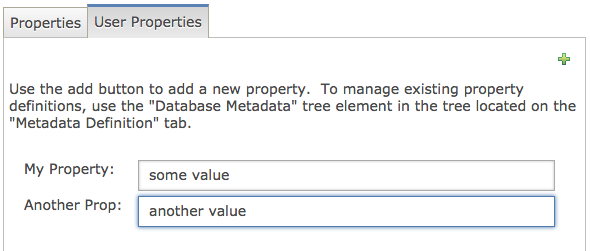 Enterprise Manager: Databases
> Settings
Enterprise Manager: Databases
> Settings
To view this topic for the preceding Enterprise Manager, see EM Java App: Database - Information Tab.
Description
The Settings tab provides a way for users to set or change the general properties of a particular database as shown below.
Click on  Databases > Settings
to display the following dialog window:
Databases > Settings
to display the following dialog window:

| Setting | Description |
|---|---|
|
DATA Location |
Location of the data files that this database is to link with once selected. For BASIS ODBC Driver version 3.0x and below, this corresponds to the DATA field in the config.tpm file. |
|
DICTIONARY Location |
Location of the data dictionary files that this database is to link with once selected. For BASIS ODBC Driver version 3.0x and below, this corresponds to the DICTIONARY field in the config.tpm file. |
Information - Date Handling
Since BBj string templates do not have a date type field, BBj uses date suffixes to determine if a field should be treated as a date value. Use this section to specify one or more date suffixes and the format that should be used to evaluate the date data.
Specify multiple date suffixes by separating each suffix with a comma. If multiple date formats are used within a single database (not advisable), up to three different formats can be specified.
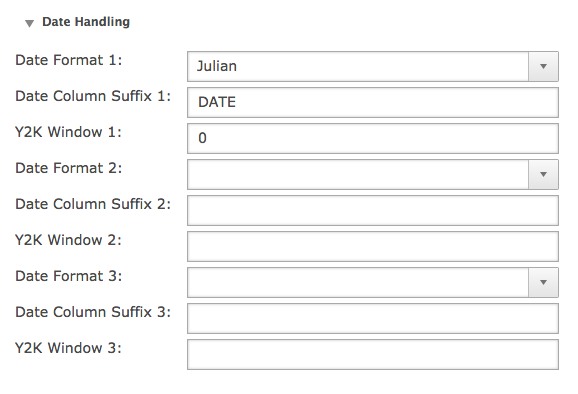
| Setting | Description |
|---|---|
|
Date Format |
Conversion class to use to convert the raw data in the column to a usable date. The list displayed in the combo box is a list of all date formats available on this BASIS DBMS (including custom date formats). |
|
Date Column Suffix |
Column suffix to use to determine if a column should be treated as a DATE type. This means that any column whose name ends with the date suffix will be considered a DATE type and apply the specified date format (see below) before evaluation. |
|
Y2K Window |
Used by date formats that store dates as 2 digit years. These date formats add 1900 to those that are greater than the Y2K window value, and add 2000 to those less than the value. |
Information - Characters/Ordering/Case Sensitivity
This section includes settings related to character encoding, case sensitivity with keys, and the type of ordering to use with ordered results.
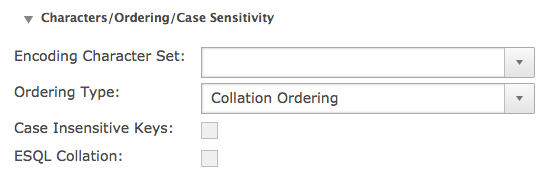
| Setting | Description |
|---|---|
|
Encoding Character Set |
Specify the appropriate character encoding if the data is encoded using a particular algorithm. |
|
Ordering Type |
Keys on non-ESQL BBj data files order character values based on byte (ASCII) value instead of “collation” order based on the alphabetizing rules of the English language. Because of this, lower case letters sort after all capital letters. This option allows you to specify the way ordering should be handled by ORDER BY. With collation order enabled, ORDER BY sorts values according to alphabetizing rules. With byte order enabled, it sorts according to ASCII character values. With collation order enabled, the SQL engine cannot rely on the key order for optimization purposes on sorting operations. However, this may not impact any of your queries since the SQL engine can still optimize on WHERE clauses and always chooses WHERE clause optimization over ORDER BY optimization when it has a choice between to the two. |
|
Case Insensitive Keys |
Tells the SQL engine to use case insensitive keys when creating indices and tables. |
|
ESQL Collation |
Uses collation order for ESQL tables. |
Information - Create Table/View Related
These settings apply to the behavior of SQL CREATE TABLE statements:
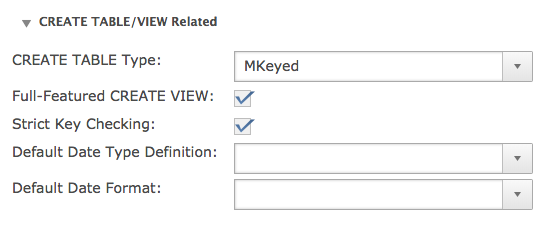
| Setting | Description |
|---|---|
|
CREATE TABLE Type |
Specifies the default type of data file to create when executing a CREATE TABLE statement. |
|
Full-Featured CREATE VIEW |
When enabled any new views or modified views will be stored as full-featured views.See BASIS SQL Gets Even Better |
|
Strict Key Checking |
With strict key checking enabled, CREATE TABLE statements must specify a primary key on one or more columns. When not enabled, the primary key does not need to be specified. However, the SQL engine will assign a primary key to the first 120 bytes of the record. Strict key checking is highly recommended. |
|
Default Date Type Definition |
If a type definition is selected here, CREATE TABLE statements will assign this type definition as the underlying data type for all DATE type columns. |
|
Default Date Format |
Default date format type to use when creating a new table. |
Information - Miscellaneous
The properties in the Miscellaneous section provide a number of configuration settings that are important for administrators to understand. Make sure to go over each property (even if you don’t believe they apply to you right now) to be aware of the various unique options available in BBj databases.
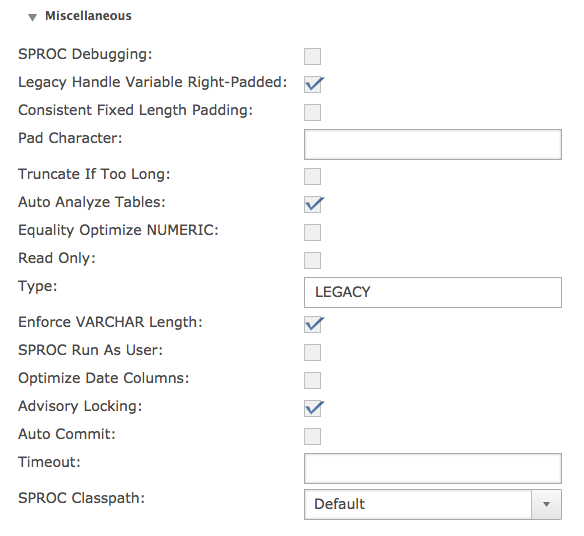
| Setting | Description |
|---|---|
|
Default NUMERIC Scale |
The scale used for NUMERIC columns in Legacy and Barista format databases. These formats do not support a scale attribute on column definitions so BBj uses this default scale when returning column information to JDBC and ODBC API calls. |
|
SPROC Debugging |
In BBj 10.00 and higher, enables or disables the ability to interactively debug stored procedures on the database. When enabled, a WinConsole will be opened on the server side when the SPROC is executed. Please see the BASIS Advantage article Debugging SPROCs and Triggers for complete details on interactively debugging stored procedures. |
| Legacy Handle Variable Right-Padded | Enable this setting to have BBj SQL assume variable length terminated column values right-padded with spaces are equivalent to those without the padding. |
|
Consistent Fixed Length Padding |
On variable length fields, this will pad them out to their complete, defined length. |
|
Pad Character |
If the Consistent Fixed Length Padding setting is enabled, this is the pad character that will be used for padding. |
|
Truncate If Too Long |
Truncates values inserted or returned to the length specified in the dictionary, if the length of the value is longer than the length in the dictionary. |
|
Auto Analyze Tables |
In BBj 10.0 and higher,enable or disable automatic table analysis. Table analysis provides the SQL engine with information it uses to better optimize SQL queries. With automatic analysis enabled, tables will be automatically analyzed (as opposed to requiring manual starting of analysis) when their structure is changed in such a way that would benefit from analysis such as the addition or removal of indices or columns. |
|
Equality Optimize NUMERICs |
BBj 10.10 and higher. BBj NUMERIC type columns are not normally ordered correctly in indices because they are stored and sorted in their string representation. Additionally, some BBx systems contain left-padding of spaces before the digits in these values. This means that even equality optimization is not possible. Therefore, the SQL engine does not include them for optimization by default. If the data is known to have no such left-padding (digits are left-aligned in the record field), equality optimization is possible. Enable this setting to define the behavior for the entire database. In version 20.20+, you may also override the global setting at the individual column level in the case where the column structure may not be consistent throughout the database. |
|
NUMERIC Empty String as Zero |
Enable this option to return a zero for any empty strings returned in type NUMERIC columns. Disable this option to return a NULL value for empty strings. |
|
Read Only |
Sets the database to read only. This overrides all user permissions set elsewhere, including the administrators. However, databases can still be administered from The Enterprise Manager. |
|
Type |
Read-only indication of the type of the database. |
|
Enforce VARCHAR Length |
With this enabled, variable length fields will give an error if you attempt to set a value that exceeds their defined length. By default, the length in variable length fields is only a "guideline". This was legacy behavior for string templates. |
|
SPROC Run As User |
Enable this setting to cause stored procedures to execute in an interpreter as the user who established the database connection. When disabled, stored procedures run as the user running BBjServices. |
|
Optimize Date Columns |
Normally, the SQL engine will not do any optimization with SQL queries using date type columns due to the fact that many date formats do not work properly when used in keys. Incorrect use of these columns in optimizing queries can result in incorrect data being returned. However, if you know for certain that your date format (when sorted by ASCII character values) works properly in keys, then selecting this option can improve the performance of some queries by telling the SQL engine to optimize on them if possible. |
|
Advisory Locking |
Sets the SQL engine to use advisory locking for its file access when accessing this database. |
|
Auto Commit |
When enabled, any ESQL table operations will use autocommit by default. This only applies to ESQL tables since they are the only types of files that support transactions. |
|
Timeout |
The number of seconds to wait for file access operations to complete if necessary. If the timeout is reached before completing the file operations, an error will occur. |
| Statement Timeout | The amount of time in milliseconds before a statement operation times out. Statement operations include the execution of any SQL statement. |
|
SPROC Classpath |
Select a specific configured classpath to use when executing stored procedures. If none is specified, stored procedures will execute using the default classpath for BBjServices. |
Information - User Props
The User Props sub-tab allows the user to define properties and values for those properties. Access these properties from SQL statements using the GLOBAL scalar function (see SQL - Custom Functions). These properties can also specify additional directories that data files can be found in (i.e. DATA1, DATA_NM, etc.). This image shows an example of some properties defined by the user:
